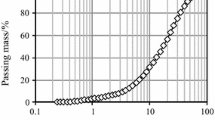Abstract
Thermal methods are used extensively in investigating cements and effects of additives on their hydration behaviour. Calcium chloride is the most effective and widely used accelerator for cement hydration, but the result is largely dependent on the rate at which it is added. In this study the influence of calcium chloride dosage on the hydration behaviour of OPC pastes aged for different periods has been investigated by means of differential scanning calorimetry (DSC), thermogravimetry (TG) and X-ray diffraction (XRD) methods. The results are discussed in relation to the relative amounts of calcium hydroxide and total reaction product formed. Chloroaluminate was a product of hydration in the samples dosed with greater than 1% calcium chloride. XRD was unable of itself to differentiate between monochloroaluminate and the calcium aluminate hydrate C4AH13 when present in small amounts. Thermal methods proved effective in characterising the products of hydration in the presence of chloride.
Zusammenfassung
Bei der Untersuchung von Zement und des Einflusses von Additiven auf das Hydratationsverhalten von Zement finden thermoanalytische Methoden eine breite Anwendung. Der effektivste und meistbenutzte Beschleuniger für die Hydratation von Zement ist Calciumchlorid, aber die Ergebnisse hängen stark von der Dosiergeschwindigkeit ab. In vorliegender Studie wird mittels DSC-, TG- und Röntgendiffraktionsmethoden der Einflu\ der Dosierung von Calciumchlorid auf das Hydratationsverhalten von verschieden alten OPC-Zementbreiproben untersucht. Die Ergebnisse wurden in Bezug auf die relativen Mengen Calciumhydroxid und das gebildete Gesamtreaktionsprodukt gewertet.
Bei Dosen von mehr als 1% Calciumchlorid konnte als Hydratationsprodukt Chloraluminat festgestellt werden. Sind Monochloraluminat und das Calciumaluminathydrat C4AH13 in geringen Mengen vorhanden, kann man zwischen den beiden mittels Röntgendiffraktion nicht unterscheiden. Thermoanalytische Methoden erwiesen sich als effektives Hilfsmittel bei der Charakterisierung der Produkte der Hydratation in Gegenwart von Chlorid.
Similar content being viewed by others
References
B. E. I. Abdelrazig, D. G. Bonner, D. V. Nowell, P. J. Egan and J. M. Dransfield, Thermochim. Acta, 145 (1989) 203.
Author information
Authors and Affiliations
Rights and permissions
About this article
Cite this article
Abdelrazig, B.E.I., Main, S.D. & Nowell, D.V. Hydration studies of modified OPC pastes by differential scanning calorimetry and thermogravimetry. Journal of Thermal Analysis 38, 495–504 (1992). https://doi.org/10.1007/BF01915514
Issue Date:
DOI: https://doi.org/10.1007/BF01915514




